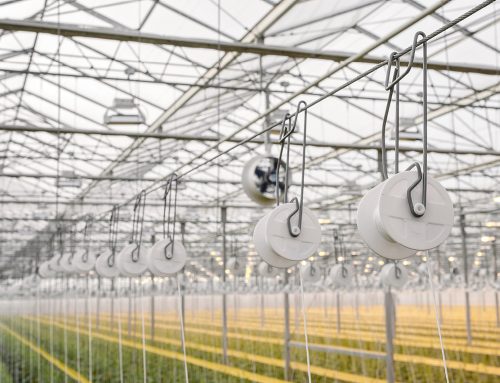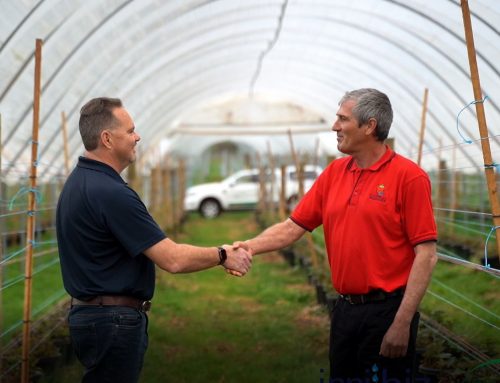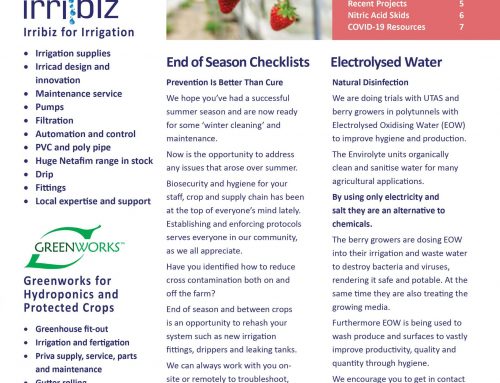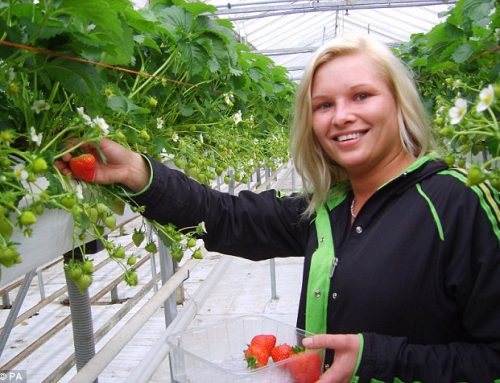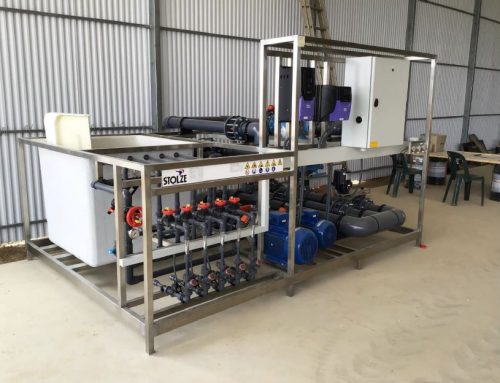
Australian winter plantings influenced by propagation.
In the coming months the crop change will take place again. Reaching your goal with the next crop starts with a well prepared young plant that meets your specific wishes and demands. To prepare for a new season a technical discussion with your propagator about plant quality, specifications and logistics is therefore very important. Especially as transport distances in Australia are huge and the number of specialist propagators limited. For these reasons Grodan technical propagation specialist Hans van Herk is once again happy to provide you with the most relevant information to start your new crop in an optimal way.
1. Target of the crop
To meet your main goals of production and quality it is crucial to have a good start to the cultivation. For that reason, the young plant must be prepared well. Goals for individual businesses can be different like an early production, a high total production or a very equal production per week. Determining this goal has effect on what type of young plant is then required. For an early production quick flowering is essential so the plant must be a very generative one with quite some age. To strengthen this a pre-planting period can be very helpful, needed for that is a larger block volume so less irrigations are required and thus a generative balance is maintained. Meaning to say business goals are strongly linked to the tools used in the propagation process.
It has to be very clear for the propagator what type of plant is desired. The development of a plant is determined by mainly age and temperature; other issues like water and fertiliser are helpful but also logical. The number of days for a young plant to develop to a certain stage is critical and it is different in every part of the world as the amount of sunlight and the day lengths vary enormously. For example, a young plant propagated in the South of Europe will develop 5-7 days faster compared to Holland. Simply copying numbers doesn’t make sense, the strategy must be tailored to the situation as a few days older or younger plants can make a significant difference.
Young plants can grow very quickly in the last week at the propagator and focusing efforts in this time frame can be the 1st difference between good and superb. The local situation is very important as light-levels can vary a lot.
2. Plant types
To reach your goal there are several possibilities regarding plant types; the following ones are possible:
• Single headed;
• Double header on the 2nd leaf;
• Double header on cotyledons.
Grafting is not a discussion anymore; the extra possibilities that a grafted plant can bring regarding density increase, CO2 usage, development speed, etc. are huge. However, grafting is a very specialised activity that demands a greater level of knowledge, skill and experience. It’s also a very labour-intensive activity and therefore costs are higher.
Worldwide the most popular plant type is a double headed plant pinched on the 2nd true leaf. This type has clearly pushed out the single headed ones. Underneath are described the biggest advantages of the double header on the 2nd leaf, as well as some negative aspects:
Double header on the 2nd leaf
Advantages:
• More generative plants as the 1st cluster is after the 6th leaf of the shoot;
• Less plants needed per ha (12.500 plants per ha);
• Powerful plants as leaf area is big enough for 2 shoots.

Generative heads
Disadvantages:
• Risk of unequal shoots;
• 1st and 2nd cluster quality can be a problem with varieties having fruit weight > 100 grams;
• More sensitive to blinding plants as big leaves are catching too many assimilates shortly after pinching (additional reason why it’s advisable to pinch and de-leaf plants at the same time).
• Increased possibility of realising 4-5 leaves between cluster 1 & 2.
Sometimes the disadvantages like non-uniformity or bad cluster quality of the 2nd leaf pinched plant are too big. This can be avoided by a high-quality propagation-level, but simple issues like lacking space can destroy this in 2-3 days. Therefore, in cases such as these a choice for the double header pinched on the cotyledons (coty’s) is reasonable.
Double header on the cotyledons
Advantages:
• Good cluster quality;
• Normal follow-up of clusters (3 leaves, 1 cluster);
• Less plants needed per ha (12.500 plants per ha);
Disadvantages:
• Weaker plants, thinner shoots;
• Approx. 1 week’s extra time needed in winter propagations;
• Clusters are initiated and formed well, but weaker as of lower leaf area.
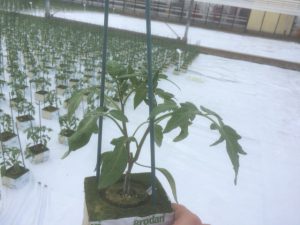
Pinched on cotyledons
Regarding these other 2 plant types the single header has more disadvantages like 25.000 plants / ha, vegetative plant with the 1st cluster after 9-11 leaves. It costs a lot of energy to balance this plant type as fruit load comes in late as well.
But still for some growers it can be an option as it can give a high total production with a lot of power during summer. Another reason can be the variety as some are not easy to develop uniformity over all shoots once pinched, in this case a single headed plant can be an option.
The Future? A 3- header!!
A new option is a plant with 3 heads to start with, so pinched on the 3rd leaf. For the propagator this is becoming challenging as this is more complicated. But nevertheless it is possible to do it and the advantages of this type make it more popular. For example, in Dutch lit tomatoes a reasonable 15-20% proportion of all crops are now being specified with 3 heads.
The advantages are:
• Less plants per ha needed;
• Planting made directly at final density;
• 3rd shoot is balancing growth better and producing seriously earlier (1.5-2 clusters).
Some disadvantages are:
• More difficult to twist the 3rd shoot in production area;
• Serious challenge for the propagator;
• Requires a larger propagation area.
Nowadays it’s done with cherries but cluster tomatoes can be expected to go in that direction as well. It is seriously advised to train yourself as a propagator to gain experience on this plant type!!
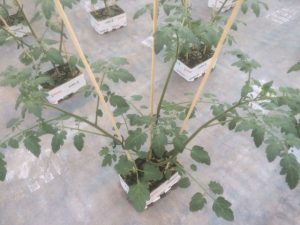
A 3-header of Juanita in final stage
3. Technical issues in propagation
Optimising knowledge is a key factor for propagators, as long-term quality is enormously important. As greenhouse businesses continue to increase in size, it’s important to deliver stable plant quality year after year and focusing on small technical details can really help.
a) Keeping shoot development equal after pinching
Handy technical issues can really optimize plant quality. Young plants are often very sensitive to a lot of things, but this can also be an advantage. Changing something, like de-leafing a plant, has a big effect.
2nd and 3rd Leaf pinched tomatoes often have the problem of non-uniform shoots and stem – stretching between the 1st and 2nd leaf. By de-leafing the 2nd and 3rd leaf partly (33-50%) or totally, the leaf area of the shoots is then balanced. As these leaves are the motor of growth for the individual shoot, balancing them solves the problem and results in a uniform height of the plant heads.
The moment of de-leafing is important and needs to be carried out the same day as pinching or at maximum 2 days later. Reason is the stretching of the top-shoot directly starts after pinching. Additional benefits of de-leafing the 2nd and 3rd leaf is minimised stem-stretching between leaf 1 & 2 so plants grow with a more compact habit from the start.

Tomato, de-leafed on the 2nd leaf
b) Optimising irrigation in propagation
Another important point is to understand what is happening in the blocks regarding WC, EC and temperature. Several trials at Dutch propagators, with logging sensors inside the blocks, have given a great insight into what’s happening. For example, on a warm / hot day the plant is eating and drinking in the morning, but in the afternoon the plant only drinks. Block temperatures may rise to 40˚C but the plant is in fact OK with it.
Another important thing to consider is that EC is only rising when WC is at a level of 40-50%. The graph underneath is showing this very nicely. So the old thought about lowering WC and rising EC is correct, but only at a certain WC. Then it will rise very quickly, which should be considered as a trend, the absolute figures are not that important anymore. To say it more simply; it doesn’t matter if there is an EC of 10 or 12; it’s both high.
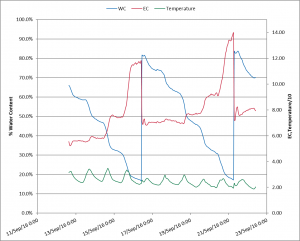
Graph of GroSens with WC and EC

Pro-block with grafted-pinched tomato (Juanita) with 3 heads
Remarks:
– irrigation moment is early in the morning;
– WC at that moment is below 20%;
– EC at driest stage is 12-14;
– re-saturation back to + 80%.
Conclusions:
– dare to go generative = dry when the plants are small;
– this works fine!!
c) Block volume
To steer in a generative direction a reasonable block volume is required. The reason is a too small volume needs a lot of irrigations. These are always vegetative with plants starting to grow / stretch due to the availability of water. As everything is grafted nowadays a higher EC does not matter for these root stocks. When the volume is bigger irrigations can be postponed; this goes for both propagators as well as growers.
Of course, this depends a lot on the type of plant and the planting moment. In summer, when planted directly, there is no need for generative steering as the conditions are already very generative (light & temperature). Alternatively, in autumn and real winter, when those 2 are limited and pre-plantings can become essential, a larger block volume will seriously help to steer plants generative by allowing a greater delay between each irrigation.
d) Spacing plants
One of the best tools to steer plants, as space creates a less humid micro climate on the floor or tables. Problematic is that space costs money, so it’s less high on the ‘bucket list’. Remember space at a very young stage can be 1-2 cm with young plants in propagation reacting very quickly to that. The reason is blocks evaporate so much that they create for just transplanted young plants a vegetative situation; therefore, a little space between blocks is helpful to improve the circulation of air and reduce the humidity. Underneath is a picture of plants in Greece at summertime when it’s hot. The stretching is avoided by spacing the plants from the moment of transplanting. Super important is to have this spacing very uniform, so in this case 15 cm from the center of each block is helping to keep the plants compact. Every centimeter of difference will have an effect of 6-7%!!!
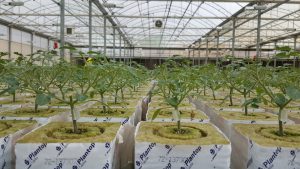
Agris Greece – Blocks spaced a little
4. Big projects
Actual situation is that there are some big projects around the country. Planting these is not an easy job; it’s a big effort. To optimise quality and uniformity it is well advised to minimise the square meters to be planted at one time, so for example at a 10 ha project it would be ideal to plant it in 4 times 2.5 ha sections. Reasons for this are planning, labour, organisation but also distance to the propagator.
This number of plants is for every propagator in the country a big batch; but also for the grower to plant it!! If 10 ha would be planted at one time it would be 125,000 double headed plants. Organisation of logistics, uniform growth, packing, planting, twisting; all is a major issue with respect to labour. It’s then very well recommended to split these actions to equalise the amount of labour required to achieve it successfully. In this situation the approximate 30,000 plants can be nicely spaced 4 times on the same floor at the propagator. The benefits will be clearly evident in plant quality, rooting in, 1st and 2nd cluster, spread of labour, etc..
5. Influence of propagation
The importance and influence of propagation have for a long time been under estimated. Mostly when there are serious problems like a shortage of plants, diseases or unevenness of shoots; do growers realise the importance of healthy plants delivered in uniform batches.
In a standard pinched tomato plant (45-50 days old) there will be 4-5 clusters initiated in the head of the plant at delivery and will be harvested 14-15 weeks after planting. Assuming the crop will be grown for 50 weeks this equates to about 25-30% of the production time (excluding the time in propagation). These clusters need to be formed by the grower. To sum up, uniformity from the propagator is so important to realising the planned business goals as the techniques used during propagation ultimately exert a large effect on overall production as all plants develop in the same direction with the same implemented growing strategy.
So, for all this I dare to state the influence of propagation is a very important one.
Hans van Herk, 2018


